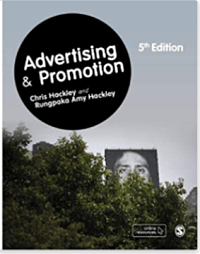New Edition of ‘Advertising & Promotion’ and the Obliteration of the Mad Men Paradigm
The advertising and promotion world is very different since the first edition of our book, Advertising & Promotion, appeared in 2005. The task with each new edition has been to keep the book current while not losing the focus on the creative agency system. One of the biggest challenges has been to debunk the persistent claim that digital platforms render traditional advertising, and its craft skills, obsolete. Accompanying this claim is often another, namely that targeted one-to-one social media advertising is a new and irresistible promotional paradigm that solves all the time-honored uncertainty around how, and if, advertising ‘works.’

Digital media have, of course, revolutionized advertising and are now central to it. For some years now most major brand ad campaigns have been executed across both mass and digital media platforms. It is well-established that digital media can amplify traditional advertising, increasing ROI and audience reach.
But it remains important in a textbook to tease out what has changed under digitization, and what has really not. Students who are the main readership for the book are typically immersed in digital media and arrive at university convinced that this shiny new paradigm has obliterated the old Mad Men advertising world of Smash Cadbury’s Martians, Milk Tray Men, Sugar Puffs Honey Monsters and Guinness Surfers, not to mention iconic ads for Levi’s 501s, VW’s Beetle or the endlessly irritating Budweiser Whassup and Wendy’s ‘Where’s the Beef’ executions (readers under ’60 can search these high water marks of pop culture in YouTube). Part of the task of the new edition is to help readers appreciate the value in old style creative advertising, and to understand how it can be translated into, and amplified by, the new digital platforms.
The first task of the 5th edition is to show readers that old fashioned ads, and old fashioned ad agencies, are still very much around. In 2019, of the circa US$300 billion global annual advertising expenditure, roughly half was spent on digital advertising including video, search and social, and the other half went on old school outdoor, TV (especially TV), radio and print. COVID has accelerated trends already present and the balance of spending will continue to shift away from traditional media advertising toward digital as the entire media industry undergoes technological and financial restructuring.
However, what has become increasingly clear is that traditional advertising and its craft skills are not only needed to pick up the slack in parts of the world where digital media are not pervasive. In highly digitized economies, too, it is clear that without creativity to arrest, engage and activate consumers, advertising cannot do its job. And, ingenious though they may be, AI machines adjusting ads on social media in real time to respond to audience behavior, cannot compete on creativity with human beings trained in the craft skills of creative advertising development. Spying on our digital behavior in order to target us with formulaic ads typically generates Click Through Rates (CTRs) of less than 1%, a miserly return considering all the hype around social media advertising, and that’s if we believe the metrics from the notoriously secretive big digital platforms.
In editions 2-4 of the book we integrated the digital perspective throughout the book’s treatment of every stage of the advertising development process. What has changed for the 5th edition is that we have also written two entirely new chapters focusing on the basics of how digital advertising operates. We feel that these new chapters, and the new and updated case examples throughout the book, will offer readers a comprehensive introduction to how advertising works, how it doesn’t, and how the advertising industry can meet the challenges of the digital age.

































































































